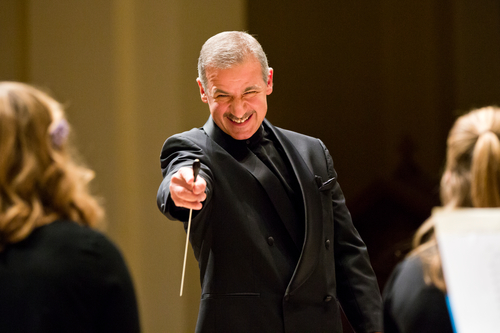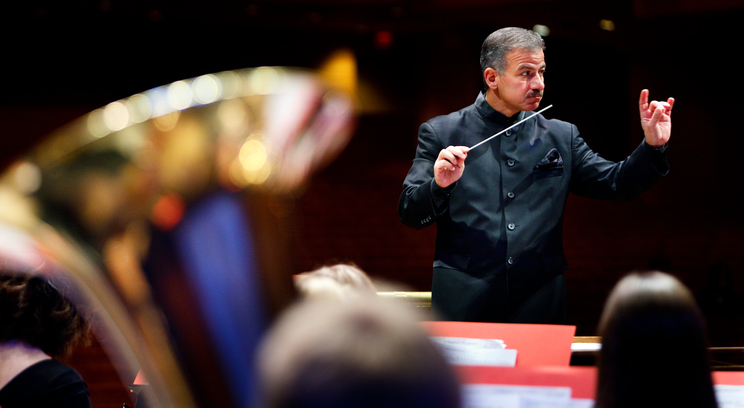Student musicians in Brady Educational Center are accustomed to reading notes on printed sheet music. They meet at the same time each week to practice. They expect their rehearsals to be conducted in a fast paced and efficient manner by Dr. Matthew George. But when the Symphonic Wind Ensemble traveled to India for two weeks in January and learned to perform a traditional piece of Indian music, it faced new challenges in an unfamiliar, different culture.
“I try to go off the beaten track when I choose where to take my students,” said George, director of bands, Symphonic Wind Ensemble and string orchestra, and chair of the St. Thomas Music Department. “I want to take them out of their comfort zone and be pushed into a different atmosphere that they wouldn’t be able to experience here.”
This wasn’t George’s first time traveling abroad to work with international composers and music ensembles. His music exchange started 19 years ago when he was invited to Mexico City to lead a weeklong seminar at the Universidad Nacional Autónoma de México. His charge was to discuss wind band music, form an experiment ensemble and give a concert.
The trip was such a success that they invited George back and asked him to direct and form what is now the Banda Sinfonica at the Escuela Nacional de Musica of UNAM. George returned to Mexico City two to three times a year to help develop the program until they finally hired a full-time conductor. People heard of the work he did there, and George began to receive invitations to work with other international ensembles.
Listen to the fourth movement of Roger Cichy's Bugs, a piece commissioned by the Symphonic Wind Ensemble in 1999.
George’s research has taken him around the world to learn about the different ways countries make and perform music. As a conductor, clinician and lecturer he has traveled across the United States, Canada, Mexico, Cuba, Costa Rica, continental Europe, Ireland and the United Kingdom, Australia, Japan, China, Brazil, Paraguay, Argentina and India. He has worked with professional groups such as the National Youth Wind Orchestra of Great Britain and the Band of the People’s Liberation Army in China. He also has conducted in prestigious venues such as the Sydney Opera House, the Oriental Arts Center in Shanghai and the National Theatre of Performing Arts as well as the Forbidden City Concert Hall in Beijing.
Perhaps the most meaningful benefit of these shared experiences is that they have allowed George to bring international composers back to St. Thomas to write original music for his students to perform.
“I think the most unique thing we do that most other music programs don’t is to commission new works of composers, particularly from other countries,” George said. In the last 22 years they have commissioned 80 new works for the symphonic wind ensemble, and at least half of those come from international composers.
Students learn more than they anticipate from the international pieces they have performed. Philip Smithley ’15 said that the band members were challenged last fall when they were given a piece of music titled “Desi Jhalak,” meaning “A Peek Into India,” written by Bollywood composer Shamir Tandon. Smithley said there is a “vast difference in the way music is rehearsed and performed in India, where it is not notated but rather improvised after years of studying, compared to Western music where all of our music is written out.”

George smiles as he ends a performance of the String Orchestra in the Chapel of St. Thomas Aquinas. (Photo by Mark Brown)
Alexandra Gobell ’13 explains that the band members are often out of their “comfort zone” when performing international pieces, but that bringing the composers to St. Thomas allows them to learn about the story behind the pieces and teaches them about the composers’ native countries. Then, when possible, George takes the students to the countries where they perform such pieces as “Desi Jhalak.” Going to India was a way for the students to experience the culture of the music that they perform.
“A very important part of our touring process is the exchange of experiences. I want the students to be able to serve the culture through their music. Instead of going somewhere passively like a tourist, I want them to be immersed in the culture by meeting with their peers and trading stories and experiences of what it’s like to make music in our country, what it’s like in their country and what the differences are,” George said.
This exchange happened between Amber Neid ’14 and composer Tandon. The song was originally sent to the band in an electronic audio format without any sheet music. Neid worked with Tandon to put the song on paper so that the band could read, rehearse and perform the piece.
“That gave us a lot of practice on aural skills rather than just reading music off a piece of paper,” Neid said. “I think that made all of us better musicians. Seeing the composer light up when he heard a ‘western ensemble’ play his traditional Indian music was worth all of the work we put into it. Then, when we played it in India, it was a huge hit because it was music the audiences could relate to, but with instruments they had never seen or heard before.”
George and the students are challenged musically when working with groups of different countries, and because they are working in a new culture.
“Whenever I’m asked to conduct national music of the country I go to, it’s really intimidating because I know everyone knows it, and I’m just now learning it,” George said. “It takes a lot of study, a lot of asking questions, a lot of listening to styles of music so I approach it and seem competent.”
George has experienced many differences between how cultures approach music and rehearse. In Latin America, he learned how musicians approach rhythm differently; “What’s popular to them is highly rhythmic dances. Instead of our Top 40 music, they listen to samba and all kinds of art and dance forms. They feel these rhythms rather than read the music on the printed page.”
There are similar challenges in China where communicating meanings of the same word is expressed by tone, and George says that their music approach also is that way with bending and inflection that our language – and music – do not possess. In England or Australia, learning new terms for familiar musical functions is the challenge. “I have to think about how I’m going to say certain things and as I speak, I have to translate the terms in my brain,” George said. The same translation process happens when he must speak Spanish in Latin America. In countries where George does not know the language, however, a translator is needed, which presents numerous challenges.
Listen to a selection form Chen Qian's Ambush! From All Sides as played by the Symphonic Wind Ensemble.
“My rehearsals are very fast-paced and to the point,” George said. “When I can’t just deliver what I want to say and I have to use a translator, I must adjust to still make it efficient. And you just hope that what the translator is saying is exactly the message that you’re trying to get across.”
In order to adapt to these situations, a certain kind of personality is needed to not only travel but also to work with people of different cultures. “If you try to force your preconceived notions onto what you’re going to experience, you’re going to be miserable. You have to have a personality that is adaptive,” George said. When he worked in Mexico, he had to get used to starting later; “When we started rehearsals at 10 a.m., we wouldn’t actually start until 11:30 a.m. At first I got upset, but then I just went with it. So, the next time we started at 11:10 a.m., then at 10:30 a.m. and then finally we started at 10 a.m. If I just tried to force it, it wouldn’t have worked.”
Traveling as part of his career was not something George expected. His first time on a plane wasn’t until he was 18 years old. Now his children, who he and his wife often bring on these trips, have seen more of the world than most adults.
“I’ve been extremely fortunate. When I started at St. Thomas I never thought my life would take me in the direction it has taken me in terms of international experiences,” George said. “The best part for me is that when I go places, people native to the culture will take me to where they go, not to where tourists go. It’s a tremendous opportunity and I feel very blessed.”
Though his interest in traveling came later in life, George’s love for music started when he was a young boy in Geneva, N.Y. “It all goes back to Herb Alpert and the Tijuana Brass,” George said. His uncle used to have eight-track tapes that he and his older cousin would listen to, and the sounds of Herb Alpert’s trumpet playing fascinated him.
When his cousin began to play trumpet, George was inspired to learn to play as well. He played trumpet from elementary school through high school, and then played professionally. But it was in high school when George’s interest in conducting began.
During study hall, George went to the band room to practice. When no one was watching, he stood on the podium and pretended that he was conducting a full band. Without knowing it, George was being watched by his band director. To encourage George’s interest in conducting, the band director let him rehearse a piece that George later conducted at a high school band concert.
“My life ambition was to become a high school band director,” George said. After receiving a B.M. in music education and trumpet performance from Ithaca College, he began teaching high school band in New York.
“I realized that there was more than just teaching music in high school; there’s also hall monitoring and cafeteria duty. I wasn’t interested in doing those things,” George said. So, he earned an M.M. degree in music education from Southern Methodist University in Dallas and a D.M.A. degree in conducting from the University of North Texas. During that time he also performed as a professional trumpet player and taught at the university and privately. George then came to St. Thomas in 1991.
Once a solo conductor in an empty band room, George has conducted some of the best bands and orchestras in the world, and his students are greatly benefiting from his passion and ambition. “Dr. George has been a huge inspiration for me as a future director, teacher and conductor,” Neid said. “Watching him conduct during our rehearsals has taught me a lot that I can’t learn at a desk,” Neid said.
The student musicians in Brady Educational Center practice and rehearse for perfection. But George gives them something more than notes on paper – he introduces them to the world through the music they play.
Read more from St. Thomas Magazine.


